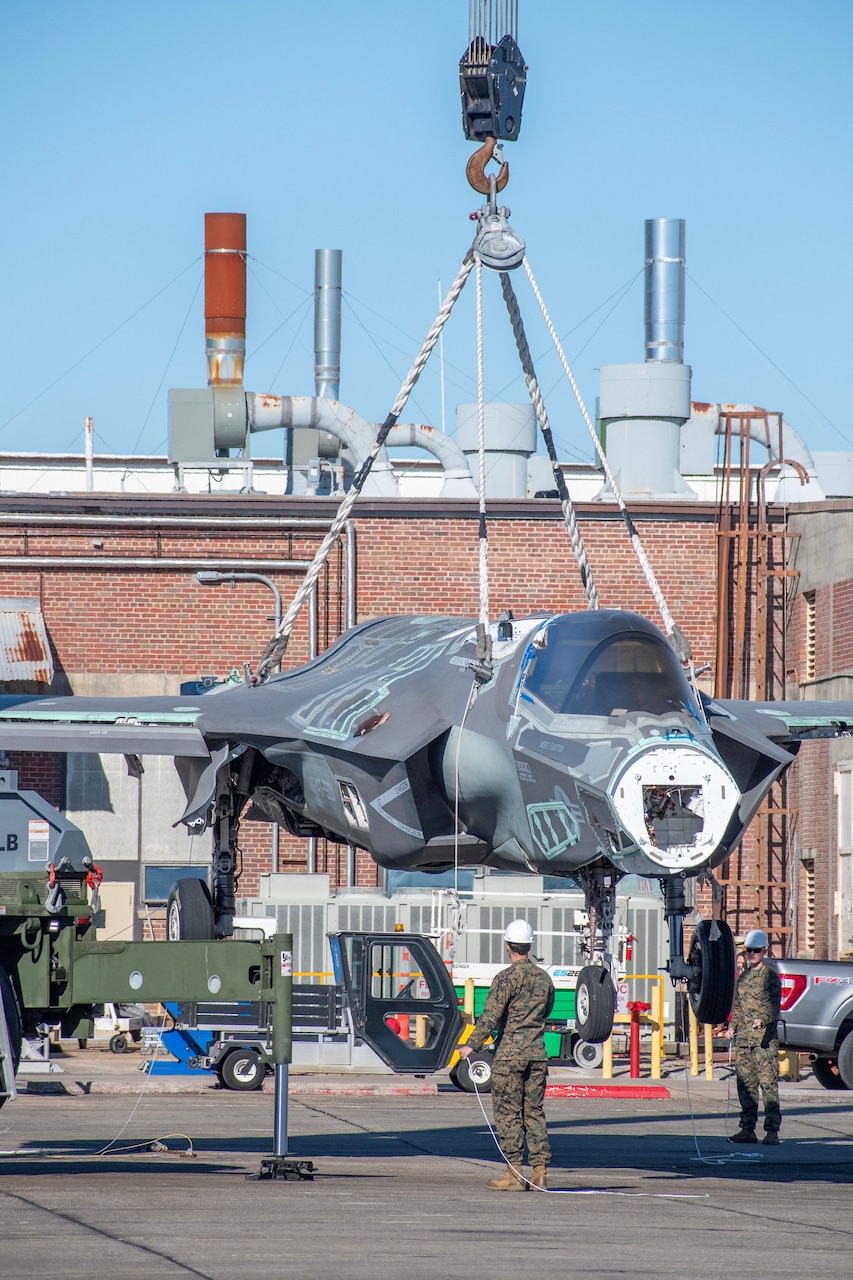
How does a Marine Corps unit train to recover a downed fighter, when no downed fighter is available to recover? At Fleet Readiness Center East (FRCE), a unique depot training asset helped Marines gain real-world experience in recovering a damaged F-35B Lightning II without risking harm to an operational aircraft.
FRCE recently partnered with Marine Wing Support Squadron 271 (MWSS-271) to assist with the squadron’s F-35 familiarization and aircraft salvage and recovery training. The collaboration with FRCE allowed MWSS-271 access to a stripped-down F-35 airframe used for training and testing at the depot, along with the knowledge and expertise provided by FRCE artisans and engineers who support the F-35 modification program.
According to Chief Warrant Officer 2 Joseph Durand, the MWSS-271 Heavy Equipment Platoon leader who also serves as the squadron’s salvage and recovery officer, the three-day training simulated the recovery of an F-35 with collapsed front landing gear. The event consisted of three phases: learning proper F-35 lifting procedures through an introductory crane lift; stowing the front landing gear and using the crane to rest the aircraft’s nose on a temporary structure to simulate landing gear failure; and finally, establishing a controlled recovery site and recovering the aircraft.
While the training event simulated one specific set of circumstances, Durand said it included techniques that can be implemented in a wide variety of recovery scenarios, both in garrison environments and at forward locations.
“Recovery has so many different scenarios, and the F-35 is a fairly new aircraft; recovery on this platform hasn’t really been conducted in a broad manner across the Marine Corps,” Durand explained. “We’re training to educate on how pertinent it is to be able to recover an F-35, the practices that go into that recovery and the hazards that come along with it. We’re really stressing the need for that aircraft to be able to get back into the air and do its job.
“What we’re looking forward to is being able to conduct this same recovery scenario, whether it be a front landing gear that went down or something more catastrophic, no matter where it happens,” he continued. “We need to be able to get that bird back into the fight, and do it in a safe manner that doesn’t harm the aircraft or the individuals working to recover it.”
FRCE’s ability to provide a nonoperational airframe for use in the Marines’ training offered the squadron unique advantages, said F-35 Branch Head Ike Rettenmair.
“Having an asset like this airframe on hand is really beneficial in terms of allowing for training without the concern of potentially damaging an operational aircraft,” he said. “While you plan for everything to go perfectly during a training event, there’s always the chance that mistakes could be made; that’s why there’s training in the first place, to provide that learning experience.
“Using an airframe that isn’t an operational aircraft helps provide a real-world, hands-on experience – everything looks, feels and moves the same – without the added pressure that comes from working with an aircraft that needs to be back on the flight line the later that day,” Rettenmair added.
Working with MWSS-271 to support the squadron’s activities also benefitted the FRCE team, Rettenmair explained.
“Supporting MWSS-271’s training not only allowed their Marines to advance their F-35 aircraft recovery skills, it also gave our team the opportunity to sharpen their expertise while serving as subject-matter experts,” he said. “Developing a way to simulate a landing gear failure, for example, presented a challenge that the team proved ready to tackle. Teaching the Marines the proper way to crane lift the aircraft provided our artisans and engineers the opportunity to refresh their skills, as well. This really was a win-win situation for everyone involved.”
Durand agreed that the partnership between the squadron and FRCE yielded positive outcomes.
“It’s extremely effective for us to drive just 15 minutes down the road to FRC East and be able to execute training with all of our partners in the warfighting effort,” he said. “It makes it extremely reliable for us to be able to conduct additional training as scenarios start to develop across the nation and around the world.”
The F-35 airframe used in this exercise, which arrived to FRCE in early 2021, has also seen use as a training aid in the depot. Its status as a readiness enhancer is not limited to supporting recovery training.
“We have also used the airframe for artisan and engineer training at FRC East, although the depot maintenance environment is definitely different than an operational unit,” Rettenmair said. “For us, the airframe serves as a training aid that helps us improve processes and procedures, which can in turn drive down the modification turnaround times and enable us to return completed aircraft to the fleet sooner than planned.”
FRCE is the lead site for depot-level maintenance on the F-35B Lightning II and has conducted modifications and repair on the Marine Corps’ short takeoff-vertical landing variant of the aircraft since 2013. The depot also performs work on the Navy’s F-35C carrier variant and the Air Force’s conventional takeoff and landing F-35A variant.
FRCE is North Carolina’s largest maintenance, repair, overhaul and technical services provider, with more than 4,000 civilian, military and contract workers. Its annual revenue exceeds $1 billion. The depot provides service to the fleet while functioning as an integral part of the greater U.S. Navy; Naval Air Systems Command; and Commander, Fleet Readiness Centers.
This "FRCE supports Marine F-35 recovery training" was originally found on https://www.navy.mil/Press-Office/News-Stories/Term/3087/


